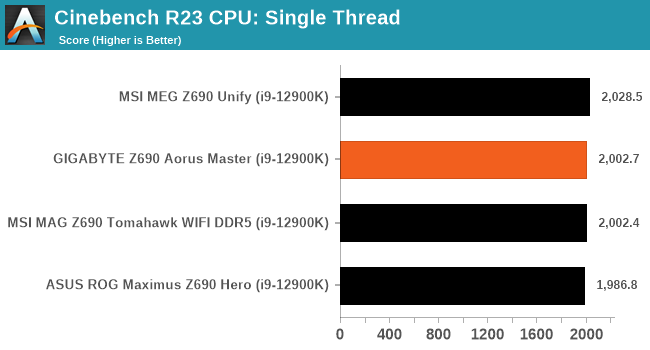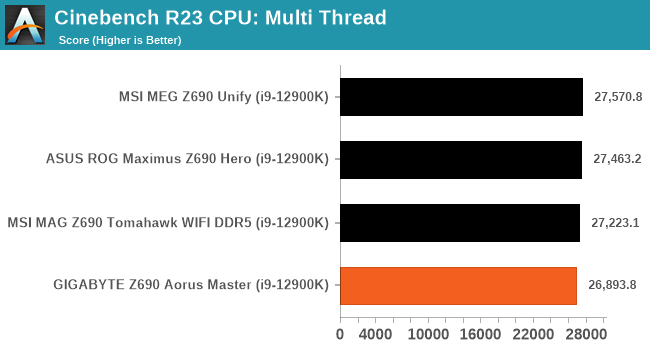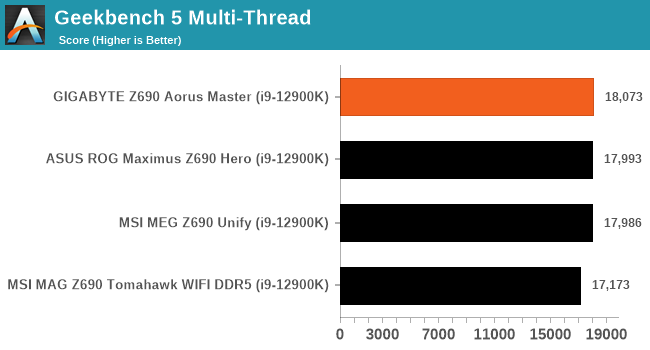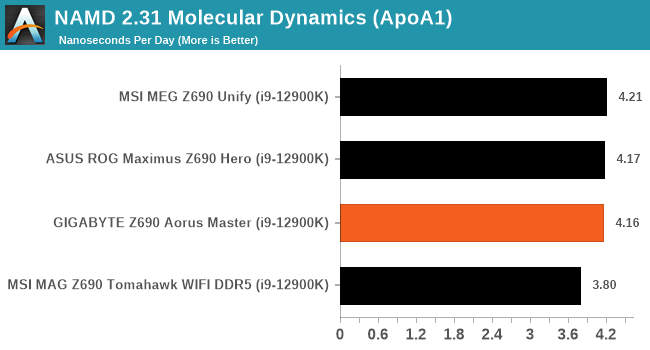The GIGABYTE Z690 Aorus Master Mobo Review: 10GbE Rounds Out A Premium Board
by Gavin Bonshor on February 25, 2022 9:00 AM ESTCPU Performance, Short Form
For our motherboard reviews, we use our short form testing method. These tests usually focus on if a motherboard is using MultiCore Turbo (the feature used to have maximum turbo on at all times, giving a frequency advantage), or if there are slight gains to be had from tweaking the firmware. We put the memory settings at the CPU manufacturers suggested frequency, making it very easy to see which motherboards have MCT enabled by default.
For Z690 we are running using Windows 10 64-bit with the 21H2 update.
Rendering - Blender 2.79b: 3D Creation Suite
A high profile rendering tool, Blender is open-source allowing for massive amounts of configurability, and is used by a number of high-profile animation studios worldwide. The organization recently released a Blender benchmark package, a couple of weeks after we had narrowed our Blender test for our new suite, however their test can take over an hour. For our results, we run one of the sub-tests in that suite through the command line - a standard ‘bmw27’ scene in CPU only mode, and measure the time to complete the render.

Rendering - Crysis CPU Render
One of the most oft used memes in computer gaming is ‘Can It Run Crysis?’. The original 2007 game, built in the Crytek engine by Crytek, was heralded as a computationally complex title for the hardware at the time and several years after, suggesting that a user needed graphics hardware from the future in order to run it. Fast forward over a decade, and the game runs fairly easily on modern GPUs, but we can also apply the same concept to pure CPU rendering – can the CPU render Crysis? Since 64 core processors entered the market, one can dream. We built a benchmark to see whether the hardware can.
For this test, we’re running Crysis’ own GPU benchmark, but in CPU render mode. This is a 2000 frame test, which we run over a series of resolutions from 800x600 up to 1920x1080. For simplicity, we provide the 1080p test here.

Rendering - Cinebench R23: link
Maxon's real-world and cross-platform Cinebench test suite has been a staple in benchmarking and rendering performance for many years. Its latest installment is the R23 version, which is based on its latest 23 code which uses updated compilers. It acts as a real-world system benchmark that incorporates common tasks and rendering workloads as opposed to less diverse benchmarks which only take measurements based on certain CPU functions. Cinebench R23 can also measure both single-threaded and multi-threaded performance.


Synthetic - GeekBench 5: Link
As a common tool for cross-platform testing between mobile, PC, and Mac, GeekBench is an ultimate exercise in synthetic testing across a range of algorithms looking for peak throughput. Tests include encryption, compression, fast Fourier transform, memory operations, n-body physics, matrix operations, histogram manipulation, and HTML parsing.


Compression – WinRAR 5.90: link
Our WinRAR test from 2013 is updated to the latest version of WinRAR at the start of 2014. We compress a set of 2867 files across 320 folders totaling 1.52 GB in size – 95% of these files are small typical website files, and the rest (90% of the size) are small 30-second 720p videos.

3DPMv2.1 – 3D Movement Algorithm Test: link
3DPM is a self-penned benchmark, taking basic 3D movement algorithms used in Brownian Motion simulations and testing them for speed. High floating point performance, MHz, and IPC win in the single thread version, whereas the multithread version has to handle the threads and loves more cores. For a brief explanation of the platform agnostic coding behind this benchmark, see my forum post here.

NAMD 2.13 (ApoA1): Molecular Dynamics
One frequent request over the years has been for some form of molecular dynamics simulation. Molecular dynamics forms the basis of a lot of computational biology and chemistry when modeling specific molecules, enabling researchers to find low energy configurations or potential active binding sites, especially when looking at larger proteins. We’re using the NAMD software here, or Nanoscale Molecular Dynamics, often cited for its parallel efficiency. Unfortunately the version we’re using is limited to 64 threads on Windows, but we can still use it to analyze our processors. We’re simulating the ApoA1 protein for 10 minutes, and reporting back the ‘nanoseconds per day’ that our processor can simulate. Molecular dynamics is so complex that yes, you can spend a day simply calculating a nanosecond of molecular movement.












35 Comments
View All Comments
thestryker - Friday, February 25, 2022 - link
I wish this had dual LAN and used the 2.5gb Intel chip as the secondary. I'm sure the Marvell 10gb is likely fine I just prefer having the safety blanket of Intel as an option on all my PCs. Otherwise it seems like a winner so long as you're willing to drop that kind of money on a motherboard.This doesn't seem like a bad price for all of the stuff they've jammed in there, but it does highlight what I've noticed about DDR5 Z690 boards. It seems like they go from barebones to premium without much in between. On the DDR4 side there certainly seems to be a lot more in the middle ground which may simply be because nobody really put out high end DDR4 boards. Hopefully when RPL lands this won't be an issue for the corresponding new motherboards.
zepi - Sunday, February 27, 2022 - link
Intel 2.5Gb chip has been super buggy and many people have problems with it. There are multiple revisions of it and even third re-release still had bugs.Jp7188 - Friday, February 25, 2022 - link
I love big heatsinks, but this board takes it a little far. That m.2 sink is so tall and close to the vid card that the backplate on my card wouldn't fit. I had to cut down the m.2 sink to make it work, which is still preferable to no sink at all.Also, the VRM sinks are too tall to allow some cpu HSFs to fit. The notctua u12s clears the RAM but not the sink at the back of the board.
Jp7188 - Friday, February 25, 2022 - link
One other gripe, I can't get a trident z5 6400 kit to work above 6000. I checked gskill's qvl and sure enough this board is one of the few missing from the list. The board is listed on the qvl for gskill's slower versions of the z5.timecop1818 - Friday, February 25, 2022 - link
imagine overclocking in 2022Silver5urfer - Saturday, February 26, 2022 - link
Why what's the problem ? Like you want to spend on a K series processor and an XMP kit and a top of the line Z series chipset for X series for AMD but want to run in on Stock OOTB clocks ? That's gigantic waste of money. Because you would be better if you do not want to tinker with a H series board and a locked SKU, save money.As for OCing itself, it's a great thing. Since people can get fun out of their tweaking the HW that they own make it personal. And get maximum possible performance out of it. Like people are not just dumb Apple iclowns who just obey what Apple says, Goolag is pretty much same now. PC is the last refuge for owning something and making it purely personal. If you have an issue probably you should stick with Apple products or something like a Surface or some BGA trash.
PeachNCream - Monday, February 28, 2022 - link
It seems like that is a lot of additional cost to personalize something in order to fill what is mainly an emotional want inside of the space of recreational computer usage. So a want within a want in a world full of needs - it may be an unwise choice to do so.Silver5urfer - Monday, February 28, 2022 - link
PC is not just a gaming machine. If anyone thinks so they should discard their overpriced PC and get a Console for $500. It's not a recreational computer usage either. A PC - Personal Computer acronym says it all. It became more and more customizable for x86 until the junk BGA laptops came into the picture taking away the customization and DIY factor.timecop1818 - Monday, February 28, 2022 - link
I wouldn't buy a "XMP kit" in the first place unless it was somehow cheaper than plain Samsung dram on a green pcb from the likes of crucial or Samsung itself. i don't need disgusting rgb crap or giant fins on heatsink for what is essentially running memory ICs designed for 1.35V (or whatever) at much higher voltages just because "you can". of course, it will fucking heat up. normal dram operation doesn't need heatsinks.Jp7188 - Tuesday, March 1, 2022 - link
DDR5 is still in its infancy. It needs high voltage and heatspeaders to approach the latency of DDR4. The non-XMP 4800 CL40 is a joke, so it's high V and heatspeaders for the time being.